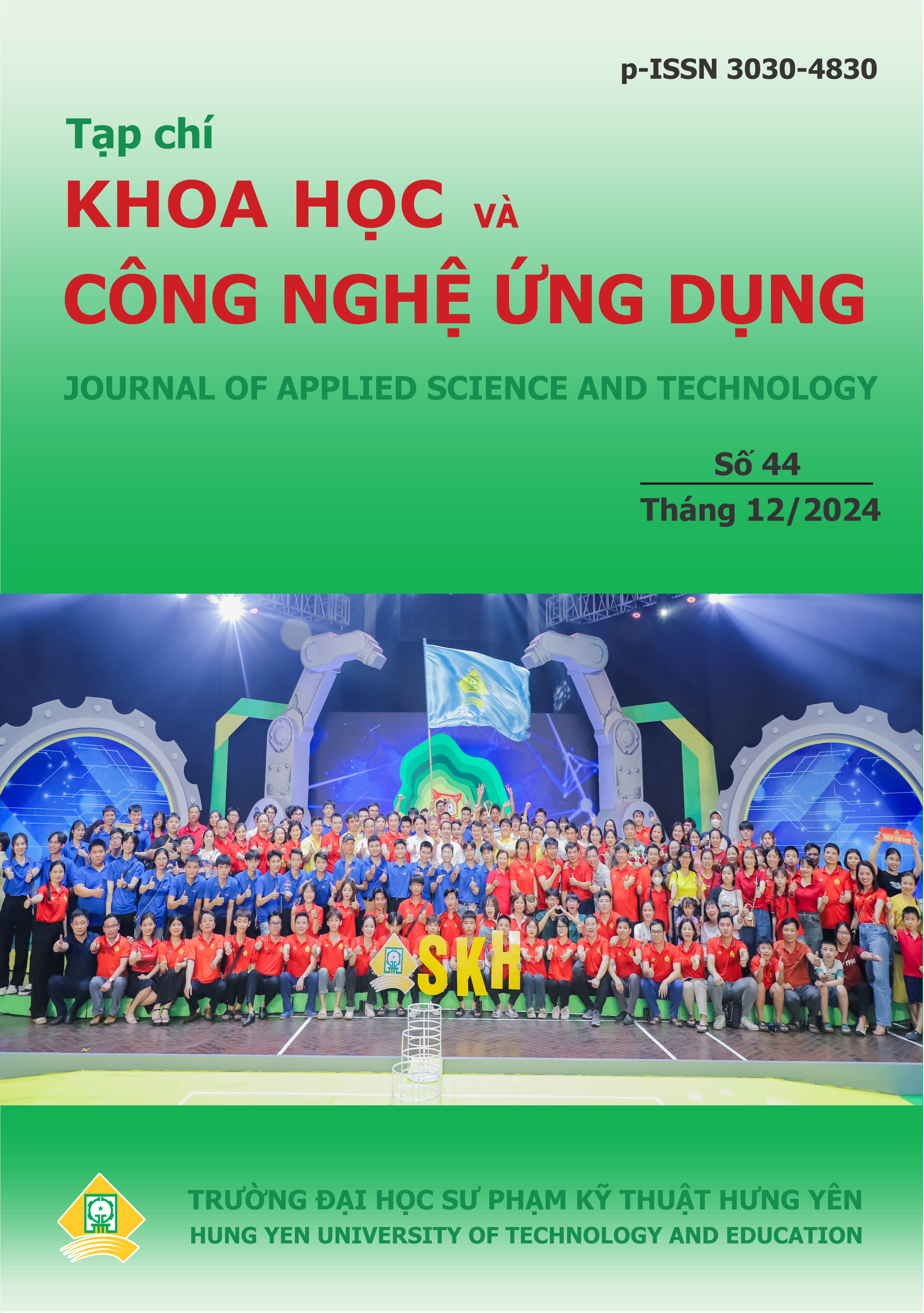STUDY ON THE INFLUENCE OF HYDRAULIC PRESSURE AND WALL ANGLE ON THE FORMING HEIGHT OF FRUSTUM-SHAPED PARTS MADE FROM AA1050 SHEET MATERIAL IN SINGLE-POINT INCREMENTAL FORMING
Abstract
This paper studies the effects of hydraulic pressure and wall tilt angle on the forming height of a quadrilateral pyramid part from AA1050 aluminum alloy plate, using the hydraulic-assisted single-point incremental forming (HS-SPIF) method. First, to evaluate the effects of hydraulic pressure (P) on the forming height, experiments were carried out with three pressure levels: 0 bar, 0.1 bar and 0.2 bar, while keeping other parameters fixed: sheet thickness (t0) = 1 mm, tool diameter (D) = 6 mm, forming depth (t) = 0.5 mm, spindle speed (S) = 2400 rpm, tool feed rate (F) = 1000 mm/min, and wall tilt angle (α) = 80°. The results show that without using hydraulic pressure, the forming height only reaches 15.85 mm. However, with 0.1 bar oil pressure, the forming height increased significantly by 28.20 % compared to the case without pressure. When the oil pressure was increased to 0.2 bar, the increase was only 9.65 % compared to the case without pressure. Next, with a fixed hydraulic pressure of 0.1 bar, the influence of the wall tilt angle on the forming height was evaluated. The experimental results showed that the forming height tended to increase as the wall tilt angle decreased. These findings not only provide insight into the design limits but also provide important recommendations for the machining of AA1050 plate parts in HS-SPIF technology.
References
S. Siengchin, “A review on lightweight materials for defence applications: Present and future developments,” Def. Technol., 2023, vol. 24, pp. 1–17, doi: 10.1016/j.dt.2023.02.025.
Schuler GmbH., Metal Forming Handbook. Cambridge: Cambridge University Press, 1998. doi: 10.1017/CBO9780511976940.
S. P. Kumar, S. Elangovan, R. Mohanraj, and S. Boopathi, “Real-time applications and novel manufacturing strategies of incremental forming: An industrial perspective,” Mater. Today Proc., 2021, vol. 46, no. xxxx, pp. 8153–8164, doi: 10.1016/j.matpr.2021.03.109.
A. Kumar and V. Gulati, “Experimental Investigation and Optimization of Surface Roughness in Negative Incremental Forming,” Measurement, 2018, no. August, doi: 10.1016/j.measurement.2018.08.078.
A. Kumar and V. Gulati, “Experimental investigations and optimization of forming force in incremental sheet forming,” Sadhana - Acad. Proc. Eng. Sci., 2018, vol. 43, no. 10, doi: 10.1007/s12046-018-0926-7.
. S. Gatea, B. Lu, J. Chen, H. Ou, and G. McCartney, “Investigation of the effect of forming
parameters in incremental sheet forming using a micromechanics based damage model,” Int. J. Mater.
Form., 2019, vol. 12, no. 4, pp. 553–574, doi: 10.1007/s12289-018-1434-3.
A. Kumar, V. Gulati, P. Kumar, V. Singh, B. Kumar, and H. Singh, “Parametric effects on formability of AA2024-O aluminum alloy sheets in single point incremental forming,” J. Mater. Res. Technol., 2019, vol. 8, no. 1, pp. 1461–1469, doi: 10.1016/j.jmrt.2018.11.001.
T. K. Hoang, T. T. Luyen, and D. T. Nguyen, “Enhancing/Improving Forming Limit Curve and Fracture Height Predictions in the Single-Point Incremental Forming of Al1050 Sheet Material,” Materials (Basel)., 2023, vol. 16, no. 23, pp. 1–19, doi: 10.3390/ma16237266.
A. Abdelhafeez Hassan, G. Küçüktürk, H. V. Yazgin, H. Gürün, and D. Kaya, “Selection of Constitutive Material Model for the Finite Element Simulation of Pressure-Assisted Single-Point Incremental Forming,” Machines, 2022, vol. 10, no. 10, doi: 10.3390/machines10100941.
A. Fatemi and B. Mollaei Dariani, “A novel experimental method for determination of forming limits with generalized non-planar stress state using hydro-assisted incremental forming,” Discov. Mech. Eng., 2024, vol. 3, no. 1, doi: 10.1007/s44245-024-00048-5.
M. Shang, Y. Li, M. Yang, Y. Chen, L. Bai, and P. Li, “Wall Thickness Uniformity in ISF of Hydraulic Support: System Design, Finite Element Analysis and Experimental Verification,” Machines, 2023, vol. 11, no. 3, doi: 10.3390/machines11030353.

